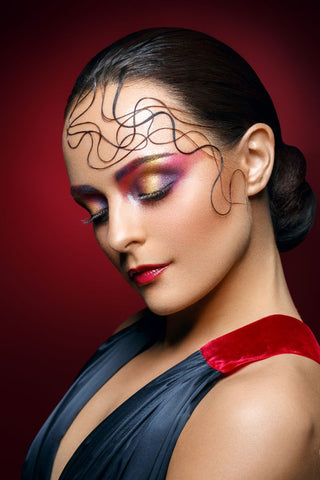
In the Beginning of Eyeshadow Application
If you are anything like me and don't know the difference between cream and powder eyeshadow or how to apply eyeshadow to the eye crease then you'll want to keep reading.
It can be very intimidating in the age of the 'beat-face' to know where to begin to create a fresh new look. Getting back to basics on general application of eyeshadow and its varying affects will help you define your own style.
What's the Difference Between Cream or Powder Eyeshadow?
When applied, cream eyeshadows initially tend to look more dramatic but the further you blend, the more they melt into the skin. Cream shadows layer beautifully and looks can range from soft, water-colored to dramatic and painterly. They also work great under powdered shadows to intensify the pigment.
With powdered shadows, they tend to sit on the surface of the skin depending on blending technique and tool. Most common eye makeup brushes used for powder shadow application are flat or paddle shaped for lid and base application. Fluffy and dome-shaped eye makeup brushes are more for lightweight shaping and overall blurring/blending, or small and dense for liner or detail work and added depth.
To Add Primer or Not?
Primer is often overlooked when it comes to applying eyeshadow. To add vibrancy to the eye, start with primer. With primer, you can create a vibrant eye statement that lasts and remain looking fresh throughout the day.
There are various priming techniques and formulas to choose from but don't over think it and keep it simple.
How To Apply Eyeshadow Primer
On clean lids, lightly apply a small amount of primer from your lash line to brow bone using clean fingertips or a lightweight blending brush. Allow a moment for it to set before applying the eyeshadow. Remember that a little goes a long way, so if you’re using a liquid or cream based primer, the size of a grain of rice should be enough for the entire lid. Simply pat and blend until the priming formula melts into your skin.
How To Apply Single Color Eyeshadow
Solo eyeshadow placement can be modern, expressive, fun, and extremely easy. This is a great technique when you’re wanting to make a true color statement. It can also be a simple base shade to even out skin tone and brighten the eye space. Base eyeshadow shades are usually very close to your skin tone or a few shades darker. It’s most often applied from lashline to crease.
Light shades brighten and enhance the eye space, while deeper shades add depth and definition. Matte shadow formulas are the foundation of eye makeup application as they add natural dimension. Shimmer shades are most often used as an accent.
For a more statement single eyeshadow, choose a vibrant cream or powder that pops on your skin tone and apply from lash line to crease. Soften any harsh edges through your crease and outer eye line with your favorite blending brush, fusing pigment into the skin. If you're really wanting to make a statement, use a single eyeshadow shade to create a bold graphic eye. Blend your shade of choice through the crease and lash line allowing for negative space on the lower lid.
How To Apply Transition and Crease Effects
One of the most important colors to use in an eyeshadow application is the transition shade. This is normally a neutral, matte shade—often a taupe, soft peach, caramel, or brown, used in between the crease color and brow bone in order to create shape and a gradient between colors. Using a transition or blending shade helps other colors meld more seamlessly into one another.
After a primer or a base shade is applied, apply a transition shade using a lightweight fluffy brush that fits snug into your eye socket, for seamless blending. Transition shades can also be applied to soften a dark crease shade and in this case, would be applied after a crease color to blur harsh edges.
To add depth and to accentuate your eye shape even more, use a crease shade. This is going to be your deepest shadow color and is most often applied into the eye socket. The denser the brush you use, the deeper the shading. For a more defined crease choose a smaller brush with a shorter and more compact brush head. For softer definition, choose a brush with longer bristles and a good amount of bend and flex to it.
How To Apply Eyeshadow Effects
Smokey, ombre, cut crease, or just soft and natural, there are endless techniques to create multi-colored effects on the eyes. Just be sure to choose a color scheme that includes a matte, a mid-toned earthy-neutral for blending, a lighter shade that can be used for base or highlighting and helps open up the eye space, along with a deeper shade for added depth and shape. Our eyeshadow palettes feature all four shades you’ll need to create a seamless look.
And, don't be afraid to mix up texture, layering powders over creams and vice versa or working with different finishes such as mattes, metallics, and shimmers. This can elevate any eye look adding natural dimension. At a bare minimum, have one dense and one fluffy brush on hand for precise placement and blending. Start with a small amount of product, layer, then blend until the effect you want is achieved. It's always easier to add than take away, especially with an eye look.
Practice does make perfect too, so find your inspiration, plan out your look, and try having a few goes to create your perfect effects before the big event. And, if you want to take things up a level, try mastering the perfect smokey eye makeup.
October 31, 2021
How To Apply Eyeshadow Like a Pro - Glo Skin Beauty

